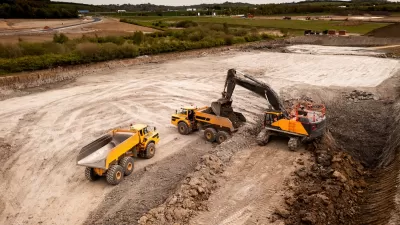A series of reports published by the U.S. Environmental Protection Agency and Smart Growth America highlights tools and policies that can help mitigate displacement pressure when recovering and developing brownfields around the United States.

Smart Growth America (SGA) and the U.S. Environmental Protection Agency’s Office of Brownfields and Land Revitalization recently created a set of anti-displacement fact sheets.
The fact sheets “highlight strategies communities can use to help mitigate displacement in the context of brownfields redevelopment,” according to an article by Jared Klukas. “Although there are many approaches to mitigating displacement during and after the completion of a brownfield redevelopment process, many communities may be unfamiliar with specific tools or how they can be implemented.”
The list of fact sheets reveals some of the tools explored as options for anti-displacement measures connected to brownfield mitigation and development. Titles include “Community Benefit Agreements,” “Community Land Trusts,” “Inclusionary Zoning,” “Small Business Preservation,” and “Tax Abatement.”
The fact sheet for inclusionary zoning (IZ), always a hot topic in planning debates, lists the benefit of the tool as the maintenance of affordable housing and housing affordable for a range of incomes in context of rising housing prices. “Research shows that inclusionary zoning programs are most effective when they are mandatory and coupled with incentives that encourage development. Incentives used to attract and encourage IZ programs for developers include density bonuses, fee waivers, parking reductions, and more streamlined and expeditious permit approval processes,” reads the fact sheet.
To create the fact sheets, the organizations conducted interviews with community groups and municipal leaders from across the country for insight into what works and what doesn’t.
FULL STORY: Anti-displacement fact sheets for communities undergoing brownfields redevelopment

Alabama: Trump Terminates Settlements for Black Communities Harmed By Raw Sewage
Trump deemed the landmark civil rights agreement “illegal DEI and environmental justice policy.”

Planetizen Federal Action Tracker
A weekly monitor of how Trump’s orders and actions are impacting planners and planning in America.

Why Should We Subsidize Public Transportation?
Many public transit agencies face financial stress due to rising costs, declining fare revenue, and declining subsidies. Transit advocates must provide a strong business case for increasing public transit funding.

Understanding Road Diets
An explainer from Momentum highlights the advantages of reducing vehicle lanes in favor of more bike, transit, and pedestrian infrastructure.

New California Law Regulates Warehouse Pollution
A new law tightens building and emissions regulations for large distribution warehouses to mitigate air pollution and traffic in surrounding communities.

Phoenix Announces Opening Date for Light Rail Extension
The South Central extension will connect South Phoenix to downtown and other major hubs starting on June 7.
Urban Design for Planners 1: Software Tools
This six-course series explores essential urban design concepts using open source software and equips planners with the tools they need to participate fully in the urban design process.
Planning for Universal Design
Learn the tools for implementing Universal Design in planning regulations.
Caltrans
Smith Gee Studio
Institute for Housing and Urban Development Studies (IHS)
City of Grandview
Harvard GSD Executive Education
Toledo-Lucas County Plan Commissions
Salt Lake City
NYU Wagner Graduate School of Public Service




























